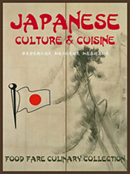|
Contents:
Home/Intro
History of Japan
Japanese Culture
Japanese Food
History
Common Dishes
Sushi
Japanese Rice
Eating with
Chopsticks
Table Settings &
Etiquette
Tea in Japan
Sake
Japanese Snacks
Japanese RECIPES
Cooking & Food Terms
Useful Words & Phrases
Food Matters
Resources & Credits
More:
Food Fare
About Food
Fare
Contact
Food Fare
Cookbooks
Culinary
Collection


E-book edition of "Japanese Culture & Cuisine" >
 |
Tea in Japan
Tea is one of the most popular beverages in Japan. It is sold at vending
machines, hot or cold. Some of the common tea-types include:
-
Aracha: Raw green
tea; contains all parts of the tea plant, including stems and
leaves.
-
Bancha:
Harvested from the second flush of Sencha between summer and
autumn.
-
Funmatsucha: Powdered
tea; similar to instant.
-
Genmaicha: Green tea
mixed with roasted brown rice; also called "popcorn" tea.
-
Gyokuro, Sencha:
Common green tea made from dried leaves.
-
Houjicha: Made from
roasted leaves.
-
Kamairicha: Also
known as pan-fried tea; leaves are not subjected to steaming
process like other Japanese teas.
-
Kocha: English tea.
-
Kukicha: Tea blend
made from stems, stalks and twigs; also known as bocha
or "twig tea."
-
Matcha: Made from
tea-leaf powder.
-
Sencha: Green tea
made without grinding the leaves.
-
Sincha: The first month's
harvest of Senacha.
-
Tamaryokucha: Tangy, berry taste.
 Taking tea is a polite way to entertain guests. The correct way to
drink a cup of tea is to take the teacup and return to your position
in the seating arrangement. Place the teacup between yourself and
your guest. After this, place the teacup in front of your knees and
bow to the guest. Then take the teacup with your right hand and
place it on the palm of your left hand. Turn the teacup to the right
twice to avoid sipping from the front of the cup, and then drink.
Finish the tea to the last drop. Lastly, turn the cup to the left
twice and place it on the table in front of you. Taking tea is a polite way to entertain guests. The correct way to
drink a cup of tea is to take the teacup and return to your position
in the seating arrangement. Place the teacup between yourself and
your guest. After this, place the teacup in front of your knees and
bow to the guest. Then take the teacup with your right hand and
place it on the palm of your left hand. Turn the teacup to the right
twice to avoid sipping from the front of the cup, and then drink.
Finish the tea to the last drop. Lastly, turn the cup to the left
twice and place it on the table in front of you.
Formal Tea Ceremony: Also known as the "The Way of Tea," the formal
Japanese tea ceremony is quite elaborate. Even before tea is served,
ceremonial preparation methods (chanoyu) are followed to the letter.
There are also different classifications of the tea ceremony,
including:
-
Chaji: Lengthy, formal service taken
with a full-course meal, desserts and thick tea (koicha).
-
Chakai: Simple service often taken
with a light meal, sweets and thin tea (usucha).
Thick tea" typically involves using the best quality tea leaves,
while "thin tea" is of lesser quality (sometimes made from tea
leaves that double as packing material). Koicha is blended gently
until smooth, adding to its felt superiority. Usucha is whipped with
a tea whisk.
The changing seasons are an important part of tea ceremonies. Those
who practice the edicts of tea ceremonies pay attention to the
seasons, which are broken into two elements: brazier (furo, May to
October) and sunken earth (ro, November to April).
Tea is usually taken on tatami floor mats, where it is prepared by
the host and served to guests. A more elaborate venue, such as
specially-built tea rooms (chashitsu) might have display alcoves,
calligraphic scrolls to mark the theme of the occasion, hearths
built into the floor, various flower arrangements, shoji screens and
separate preparation areas (mizuya). Some of the common equipment (chadogu)
used to prepare tea includes bowls (chawan), caddies (natsume),
linen and hemp clothes for clean-up (chakin), bamboo scoops (chashaku)
and whisks (chasen).
Elements of the tea ceremony are also related to Zen Buddhism, which
promotes harmony as well as the simple enjoyment of the event
itself.

•
Next: Sake >
|




